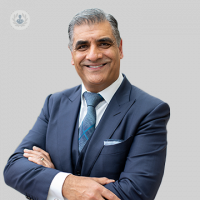Crossing the bridge: what is myocardial bridge?
Written in association with:A myocardial bridge is when a portion of heart muscle crosses over an artery in the heart. It is not necessarily a cause for concern, but there can be complications that arise. In this article, a consultant cardiac surgeon, Mr Inderpaul Birdi, explains the myocardial bridge, the issues related to it, and what can be done to address them.

What is a myocardial bridge?
In the heart, arteries typically sit near the surface, supplying oxygen-rich blood. However, sometimes a muscle grows over an artery, creating a ‘bridge’. It is not uncommon, as nearly one-fifth of the population is recorded as having it – although, there are estimates that more people have myocardial bridges, but they do not experience any issues or symptoms and therefore do not seek diagnosis.
What are the signs of a myocardial bridge?
The symptoms that can occur with myocardial bridges include:
- Chest pain, squeezing, or tightness in the chest
- Dyspnoea
- Fatigue
- Dizziness
- Palpitations or irregular beats
These symptoms may be exacerbated during times of emotional stress, excitement, or physical activity. This is because the myocardial bridge can compress the artery underneath, reducing blood flow to the heart. Heart muscles are what action heartbeats, so the muscle will squeeze and flex during beats, inadvertently obstructing the blood from flowing as it should.
If the symptoms are present and persist without treatment, they can develop into more serious complications like acute coronary syndromes, spasms, arrhythmias, and sudden cardiac death like a heart attack.
How is a myocardial bridge diagnosed?
The symptoms of a myocardial bridge are very similar to other heart conditions like angina, which may lead to the condition being mis- or undiagnosed. That is why cardiologists may conduct several tests to identify the issue, such as:
- Coronary angiographies, in which catheters, guided by X-rays, are passed through the artery of either the groin or arm. A dye, called a contrast medium, is injected and further X-rays are taken to see how the blood, now dyed, moves through the heart.
- CT angiographies, which also use injected contrast medium and multiple X-ray scans of the heart are taken to produce detailed images of the blood vessels and the tissues of the heart.
- Intravascular ultrasounds, which use catheters that emit sound waves and record the echoes that bounce back to generate real-time images of blockages or obstructions.
- Exercise stress tests, which monitor how the heart performs during physical activity to see if there is any dysfunction.
How are myocardial bridges treated?
A majority of patients will not require treatment for their myocardial bridges if they are not causing problems. Those patients who do struggle with the symptoms, however, can explore several treatment options.
Medications like beta-blockers or calcium channel blockers can slow the heart rate, thus decreasing the compression on the bridged artery.
Lifestyle changes to reduce stress and heart overactivity. This can be done by altering physical exercise routines and hobbies, or undertaking meditation and relaxing practices to soothe the heart.
For those who have more extreme and adverse symptoms, and have not found other methods of treatment fruitful, more interventional methods may be recommended. This could be an angioplasty, which is a procedure to keep the artery open by inserting a balloon and a stent into the artery via a catheter. When the balloon is inflated, it expands the stent which will remain after the balloon and catheter are removed, providing structure to the artery and facilitating easy blood flow. Or it could be a surgical procedure to remove the bridging muscle entirely, which is considered the last option.
If you are experiencing heart pain or palpitations, you can consult with Mr Birdi via his Top Doctors profile.


